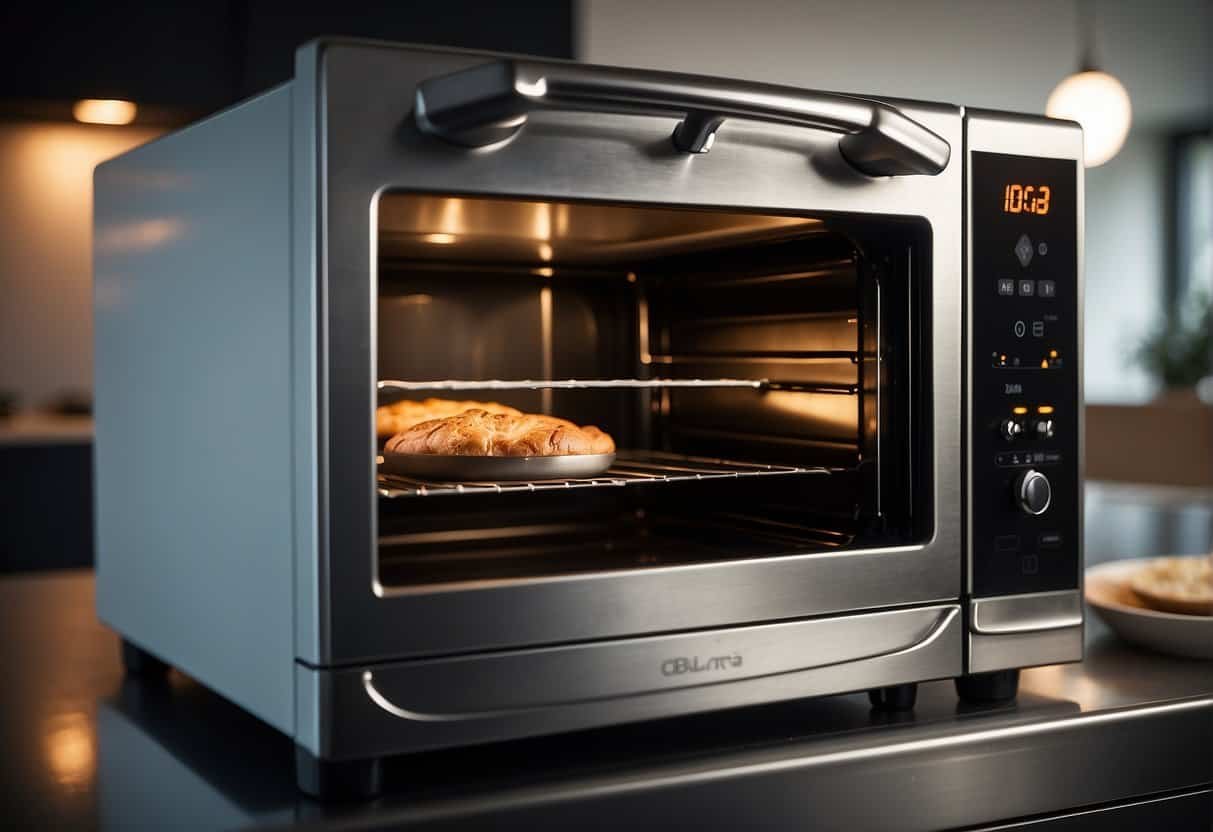Table of Contents
The self-cleaning feature on modern ovens is a significant time-saver for those of us who enjoy cooking but could do without the arduous task of scrubbing the oven’s interior. Understanding how this feature works can help us use it effectively and maintain our ovens in top condition.
Generally, I find that most self-cleaning ovens employ a high-temperature cycle known as pyrolytic cleaning, where the oven locks itself and heats up to a temperature usually between 800 to 1,000 degrees Fahrenheit to burn off food residue.

During this process, any spills, grease, and grime inside the oven are incinerated, leaving behind a small amount of ash. After the cycle completes, which can take a few hours, and the oven cools down, I simply wipe away the ash with a damp cloth.
It’s fascinating to learn about the different types of self-cleaning ovens, such as those using high-heat cleaning to effectively burn off residue, turning it into ash, which corresponds with the information provided on how and when to utilize the self-cleaning function.
It’s essential for me to note that while using the self-cleaning function is convenient, it requires some precautions. I ensure that the kitchen is well-ventilated to handle the smoke that can be produced during the cleaning cycle.
Additionally, removing any major spills or large pieces of debris before running the cycle can help prevent excessive smoke and potential fire hazards.
It’s also good to be aware of the two main types of self-cleaning ovens: those that use high heat, and the newer models that offer a steam-cleaning option which uses heat and water to loosen soil, making it easier to clean with less heat.
Understanding Self-Cleaning Ovens
Self-cleaning ovens are a high-tech convenience, designed to reduce the effort required to maintain a clean oven interior. They achieve this either through high-temperature heating, known as pyrolytic cleaning, or steam to soften residues.
Basic Working Principle
I find that at the core of a self-cleaning oven’s functionality is its ability to elevate temperatures to an extreme degree or use steam. During the oven’s self-clean cycle, my oven locks itself and heats up to around 880°F (471°C) for pyrolytic models or generates steam in steam cleaning versions.
The high temperatures incinerate food particles and spills, turning them into ash, which I later wipe away without the need for harsh cleaning chemicals.
Types of Self-Cleaning Ovens
There are principally two types of self-cleaning ovens that I might consider:
-
Pyrolytic Cleaning: These ovens use intense heat, often reaching above 800°F, to burn off grease and food residue. A cycle can last from 2 to 6 hours, during which the oven door remains locked for safety.
-
Steam Cleaning: This type is less extreme, utilizing steam to help loosen soil in the oven. Steam cleaning usually takes less time and involves lower temperatures, making it a faster, but sometimes less thorough, cleaning option.
By harnessing either high heat or steam, self-cleaning ovens offer a helping hand to keep the interior sparkling without manual scrubbing.
The Self-Clean Cycle Process
The self-clean cycle in modern ovens is a built-in feature designed to minimize manual cleaning efforts. I’ll guide you through how to prepare for a cycle, what happens during the cleaning phases, and what actions to take after completion.
Preparation and Precautions
Before initiating the self-clean cycle, I ensure that the oven is empty, removing all pans and aluminum foil. The oven door needs to be closed securely, as most models are designed to automatically lock the door before the high-heat cycle commences.
This is a safety feature to prevent accidents, as the temperatures will rise significantly. I recommend checking and following the specific instructions in the owner’s manual for safety guidance and cycle duration.
- Remove all oven racks and cookware
- Ensure the oven is cooled if it was recently used
- Lock the oven door manually if it doesn’t lock automatically
The Cleaning Phases
During the self-clean cycle, the oven’s temperature will spike to extreme levels, usually between 800º to 875ºF, effectively incinerating all the food residue and grease in the oven. This is what is generally referred to as the heat phase, which turns these remnants into ash.
During this stage, smoke and fumes can be emitted, which might affect individuals with respiratory concerns, pets, or lead to the triggering of smoke alarms.
Heat Phase: Temperatures rise to burn off residue.
- Safety: Stay clear of the oven and ensure the area is well-ventilated.
Cooling Phase: The oven cools and oven components endure less stress.
- Door Lock: Remains engaged until temperatures drop to safe levels.
After the Cycle Completion
Once the cycle is complete and the oven door unlocks, indicating that the interior has cooled sufficiently, I carefully wipe out the residual ash from the bottom of the oven.
It’s recommended to use a damp cloth or sponge to avoid inhaling any ash. Finally, the oven racks can be replaced, and the oven is ready for its next use.
- Wait for the door to unlock automatically
- Wipe the oven interior using a damp cloth
- Ventilate the room if there’s any lingering odor
By following the proper steps and precautions, the self-clean cycle is a convenient feature that maintains the oven while limiting the need for harsh chemicals or strenuous scrubbing.
Maintenance and Safety

When it comes to maintaining and safely operating a self-cleaning oven, I focus on precise frequencies for cleaning and heed important safety measures to prevent accidents.
Regular Maintenance Tips
For optimal performance, I suggest conducting a self-clean cycle every four to six months, depending on usage. Here’s my approach:
- Racks: I always remove oven racks before the self-cleaning cycle to prevent discoloration and potential damage.
- Soil: I wipe up major spills before running a self-clean cycle to minimize smoke and odor.
- Chemical cleaners: I avoid using them inside my self-cleaning oven; the high temperatures are designed to handle the cleaning without chemical assistance.
Safety Considerations During Use
Safety is paramount. Below are considerations I always keep in mind:
- Oven Vents: I ensure the oven vent is unblocked to allow proper airflow and venting of fumes.
- Precautions: I stay vigilant and never leave the house when my oven is in self-cleaning mode.
- Children and Pets: I keep them away from the kitchen during a cleaning cycle due to high temperatures and potential odors.
Troubleshooting Common Issues

When it comes to maintaining my self-cleaning oven, I’ve encountered a few common problems that can arise. These issues often pertain to unpleasant odors and persistent residue that can affect the functionality and cleanliness of the oven.
My goal is to resolve these efficiently and safely, ensuring the oven’s self-cleaning feature functions optimally without the need for harsh chemicals.
Handling Odors and Smoke
If I notice smoke and fumes during the self-cleaning cycle, first, I ensure there’s adequate ventilation by opening windows or using the exhaust fan. The presence of smoke often signifies leftover food debris or grease in the oven interior that’s burning off.
To minimize this, I manually clean large spills and remove significant debris before starting the self-cleaning process. After the cycle, if odors linger, placing a dish of vinegar or lemon juice inside while the oven is warm, but not hot, can help neutralize the smell.
Resolving Oven Cleaning Problems
At times, the oven’s self-cleaning feature may struggle with certain residues. If I find areas that aren’t clean after the cycle, I prepare a paste of baking soda and water and apply it to the affected spots, avoiding any heating elements. After a few hours, I wipe it away with a damp cloth.
This method allows me to clean my self-cleaning oven without resorting to harsh chemicals that could damage the oven’s interior or compromise future self-cleaning cycles.









